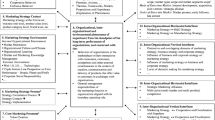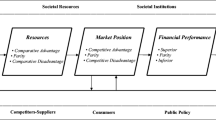Abstract
This article provides a high-level overview of marketing strategy research and offers a number of suggestions of areas ripe for future research. We discuss the most fundamental concepts that continue to drive current marketing strategy research and examine how these concepts have shaped marketing strategy and the role of the marketing function. In addition, we highlight the developments in marketing accountability, marketing’s influence within the firm, and alternatives to a market-driven approach in generating sustainable competitive advantage. Finally, we identify directions for future research in the light of recent developments, availability of new data, and emerging issues.
Similar content being viewed by others
References
Aaker, D. A., & Jacobson, R. (2001). The value relevance of brand attitude in high-technology markets. Journal of Marketing Research, 38(November), 485–493.
Ailawadi, K. L., Lehmann, D. R., & Neslin, S. A. (2001). Market response to a major policy change in the marketing mix: Learning from Procter & Gamble’s value pricing strategy. Journal of Marketing, 65(1), 44–61.
Ailawadi, K. L., Lehmann, D. R., & Neslin, S. A. (2003). Revenue premium as an outcome measure of brand equity. Journal of Marketing, 67(4), 1–17.
Barksdale, H. C., & Darden, B. (1971). Marketers’ attitudes toward the marketing concept. Journal of Marketing, 35(4), 29–36.
Besharov, M. L., & Smith, W. K. (2014). Multiple institutional logics in organizations: Explaining their varied nature and implications. Academy of Management Review, 39(3), 364–381.
Boulding, W., Moore, M. C., Staelin, R., Corfman, K. P., Dickson, P. R., Fitzsimons, G., Gupta, S., Lehmann, D. R., Mitchell, D. J., Urbany, J. E., & Weitz, B. A. (1994). Understanding managers’ strategic decision-making process. Marketing Letters, 5(4), 413–426.
Burkhardt, J., Gillingham, K., & Kopalle, P. K. (2019). “Experimental evidence on the effect of information and pricing on residential electricity consumption”, Working Paper. Hanover: Tuck School of Business at Dartmouth, Dartmouth College.
Carpenter, G. S., & Lehmann, D. R. (1985). A model of marketing mix, brand switching, and competition. Journal of Marketing Research, 22(3), 318–329.
Carpenter, G. S., & Nakamoto, K. (1989). Consumer preference formation and pioneering advantage. Journal of Marketing Research, 26, 285–298.
Carpenter, G. S., Glazer, R., & Nakamoto, K. (1997). Readings on Market-Driving Strategies: Towards a New Theory of Competitive Advantage. Reading: Addison Wesley Longman.
Davis, S., Inman, J. J., & McAlister, L. (1992). Promotion has a negative effect on brand evaluations-Or Does It? Additional Disconfirming Evidence. Journal of Marketing Research, 29, 143–148.
Deshpandé, R., Farley, J. U., & Webster Jr., F. E. (1993). Corporate culture, customer orientation, and innovativeness in Japanese firms: A Quadrad Analysis. Journal of Marketing, 57(January), 23–37.
Farley, J. U., Katz, J., & Lehmann, D. R. (1978). Impact of different comparison sets on evaluation of a new subcompact car brand. Journal of Consumer Research, 5(2), 138–142.
Fornell, C., Mithas, S., Margeson III, F. V., & Krishnan, M. S. (2006). Customer satisfaction and stock prices: High returns, low risk. Journal of Marketing, 70(January), 3–14.
Germann, F., Ebbes, P., & Grewal, R. (2015). The chief marketing officer matters! Journal of Marketing, 79, 1–22.
Green, P. E., & Srinivasan, V. (1978). Conjoint analysis in consumer research: Issues and outlook. Journal of Consumer Research, 5(September), 103–123.
Guadagni, P. M., & Little, J. D. C. (1983). A logit model of brand choice calibrated on scanner data. Marketing Science, 2, 203–238.
Gupta, S., Lehmann, D. R., & Stuart, J. A. (2004). Valuing customers. Journal of Marketing Research, 41(February), 7–18.
Hise, R. T. (1965). Have manufacturing firms adopted the marketing concept? Journal of Marketing, 29(3), 9–12.
Homburg, C., & Pflesser, C. (2000). A multiple-layer model of market-oriented organizational culture: measurement issues and performance outcomes. Journal of Marketing Research, 37(4), 449–462.
Homburg, C., Workman Jr., J. P., & Krohmer, H. (1999). Marketing’s influence within the firm. Journal of Marketing, 63(2), 1–17.
Humphreys, A., & Carpenter, G. S. (2018). Status games: Market driving through social influence in the U. S. Wine Industry. Journal of Marketing, 82(September), 141–159.
Jaworski, B. J., & Kohli, A. K. (1993). Market orientation: Antecedents and consequences. Journal of Marketing, 57(3), 53–70.
Johnson, R. M. (1971). Market segmentation: A strategic management tool. Journal of Marketing Research, 8(1), 13–18.
Kirca, A. H., Jayachandran, S., & Bearden, W. O. (2005). Market orientation: A meta-analytic review and assessment of its antecedents and impact on performance. Journal of Marketing, 69, 24–41.
Kohli, A. K., & Jaworski, B. J. (1990). Market orientation: The construct, research propositions, and managerial implications. Journal of Marketing, 54(2), 1–18.
Kotler, P. (1967). Marketing Management: Analysis, Planning, and Control. Upper Saddle River: Prentice Hall.
Lehmann, D. R. (1971). Evaluating marketing strategy in a multiple brand market. Journal of Business Administration, 3(Fall), 15–26.
Lehmann, D. R., & Pan, Y. (1994). Context effects, new brand entry, and consideration sets. Journal of Marketing Research, 31(3), 364–374.
McNamara, C. P. (1972). The present status of the marketing concept. Journal of Marketing, 36(1), 50–57.
Mela, C., Gupta, S., & Lehmann, D. R. (1997). The long-term impact of promotion and advertising on consumer brand choice. Journal of Marketing Research, 34(2), 248–261.
Moorman, C., & Rust, R. T. (1999). The role of marketing. Journal of Marketing, 63, 180–197.
Narver, J. C., & Slater, S. F. (1990). The effect of a market orientation on business profitability. Journal of Marketing, 54(4), 20–35.
Nath, P., & Mahajan, V. (2011). Marketing in the C-suite: A study of chief marketing officer power in firms' top management teams. Journal of Marketing, 75(1), 60–77.
O’Sullivan, D., & Abela, A. V. (2007). Marketing performance measurement ability and firm performance. Journal of Marketing, 71(April), 79–93.
Oblander, E. S., Gupta, S., Mela, C. F., Winer, R. S., & Lehmann, D. R. (2020). The past, present, and future of customer management. Marketing Letters, 31(2), Xx–Xx.
Patvardhan, S., & Ramachandran, J. (2020). Shaping the future: Strategy making as artificial evolution. Organization Science, 31(3), 671–697.
Rust, R. T., Ambler, T., Carpenter, G. S., Kumar, V., & Srivastava, R. K. (2004). Measuring marketing productivity: Current knowledge and future directions. Journal of Marketing, 68(4), 76–89.
Schmalensee, R. (1982). Product differentiation advantages of pioneering brands. American Economic Review, 72(3), 349–365.
Urban, G. L. (1975). PERCEPTOR: A model for product positioning. Management Science, 21(8), 858–871.
Verhoef, P. C., & Leeflang, P. S. H. (2009). Understanding the marketing department’s influence within the firm. Journal of Marketing, 73(March), 14–37.
Washington, M., & Zajac, E. J. (2005). Status evolution and competition: Theory and evidence. Academy of Management Journal, 48(2), 282–296.
Webster Jr., F. E. (1992). The changing role of marketing in the corporation. Journal of Marketing, 56(October), 1–17.
Whitler, K. A., Krause, R., & Lehmann, D. R. (2018). When and how board members with marketing experience facilitate firm growth. Journal of Marketing, 82(September), 86–105.
Author information
Authors and Affiliations
Corresponding author
Additional information
Publisher’s note
Springer Nature remains neutral with regard to jurisdictional claims in published maps and institutional affiliations.
The references with * appear in ESM.
Electronic supplementary material
ESM 1
(DOCX 28.5 kb)
Rights and permissions
About this article
Cite this article
Sozuer, S., Carpenter, G.S., Kopalle, P.K. et al. The past, present, and future of marketing strategy. Mark Lett 31, 163–174 (2020). https://doi.org/10.1007/s11002-020-09529-5
Published:
Issue Date:
DOI: https://doi.org/10.1007/s11002-020-09529-5




